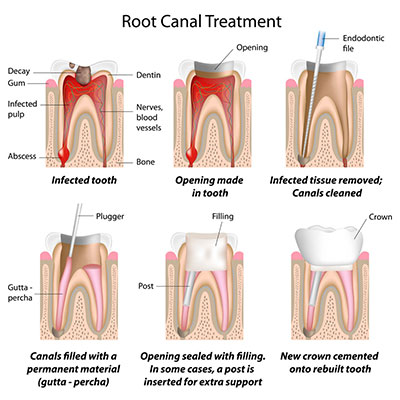Endodontics – Root Canal Therapy
Root Canal Treatment Can Save Your Tooth
Your teeth are meant to last a lifetime. Years ago, diseased or injured teeth were often pulled. But today, even if the pulp inside one of your teeth is injured or infected, the tooth often can be saved through root canal (endodontic) treatment. Endodontics (end-o-DON-tics) is the branch of dentistry that deals with treating diseases or injuries to the dental pulp. An endodontist is a dentist who specializes in root canal and other endodontic treatments.
What happens if the dental pulp is injured?
The pulp is soft tissue inside the tooth that contains blood vessels and nerves. When the pulp is diseased or injured and unable to repair itself, it dies. The most common causes of pulp death are a cracked tooth, a deep cavity, problems with large fillings, or serious injury to the tooth. All of these can allow bacteria to enter into the pulp.
Why should the pulp be removed?
If the problem pulp is not removed, the tissues around the root of the tooth can become infected, often resulting in pain and swelling. Even if there is no pain, bacteria can damage the bone that anchors the tooth in the jaw. Without treatment, the tooth may have to be pulled.
What does treatment involve?
Root canal treatment involves one or more visits. There are several steps that your dentist or endodontist will perform to save your tooth:
- First, your tooth is numbed for your comfort. The dentist will put a thin sheet of latex rubber over your tooth to keep the tooth dry. An opening is made through the crown of the tooth into the pulp chamber.
- The tooth’s nerve or pulp is then removed from both the inside of tooth (pulp chamber) and the root canal (the space inside the root). Each root canal is cleaned and shaped so it can be filled.
- Medicine may be placed in the pulp chamber and root canal to help get rid of bacteria.
- A temporary filling will be placed in the opening of the tooth to stop saliva from getting into the chamber and root canals. You might also be given antibiotics if infection has spread beyond the end of the root(s). If your dentist prescribes medicine, use it only as directed. If you have any problems with the medicine, call your dentist.
- During the next stage of treatment, the temporary filling is removed. The root canals are usually filled with a rubber-like material to seal them.
- In the final step, the tooth may be restored by a crown or a filling to strengthen it and improve the way it looks. If an endodontist performs the root canal treatment, he or she will usually recommend that you return to your general dentist for this step.

